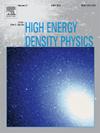宇宙学中的f(R,Lm,T)引力理论用引力解耦
IF 0.9
3区 物理与天体物理
Q3 PHYSICS, FLUIDS & PLASMAS
引用次数: 0
摘要
本文考虑了现有的各向同性动力学球对称解,并通过最近提出的一种格式扩展了其范围,在基于拉格朗日的引力模型框架内讨论了引力源的解耦问题。在种子完美物质中加入额外的流体分布后,实现最小几何变形方法,从而得到两组不同的场方程。由于我们的目标是讨论宇宙演化的不同阶段,第一组是通过考虑平面FLRW模型以及特定形式的比例因子来处理的。我们还使用了一个正压状态方程,它有助于实现我们的目标。对于第二集,采用类密度约束使系统唯一可解。在这样做之后,我们用一些特殊的关系把描述两种流体装置的场方程的解结合起来。对解耦的影响和所考虑的模型参数进行了详细的图解讨论。最后,我们得出结论,所考虑的修正理论支持两个进化阶段,即辐射和物质主导时代。本文章由计算机程序翻译,如有差异,请以英文原文为准。
Cosmology in f(R,Lm,T) gravity theory using gravitational decoupling
This article considers the existing isotropic dynamical spherically symmetric solution and extends its domain through a recently proposed scheme, refers to the decoupling of gravitational sources within the framework of Lagrangian-based gravity model. After adding an additional fluid distribution into the seed perfect matter, the minimal geometric deformation approach is implemented that leads to a couple of distinct sets of field equations. Since we aim to discuss different phases of cosmic evolution, the first set is handled by considering the flat FLRW model along with a particular form of the scale factor. We also employ a barotropic equation of state which helps in achieving our goal. As the second set is concerned, a density-like constraint is adopted to make the system uniquely solvable. After doing so, we combine the solutions of field equations characterizing both fluid setups using some particular relations. A detailed graphical discussion on the impact of the decoupling and the considered model parameters is also carried out. Finally, we conclude that the modified theory under consideration supports two evolutionary phases such as the radiation and matter-dominated epochs.
求助全文
通过发布文献求助,成功后即可免费获取论文全文。
去求助
来源期刊

High Energy Density Physics
PHYSICS, FLUIDS & PLASMAS-
CiteScore
4.20
自引率
6.20%
发文量
13
审稿时长
6-12 weeks
期刊介绍:
High Energy Density Physics is an international journal covering original experimental and related theoretical work studying the physics of matter and radiation under extreme conditions. ''High energy density'' is understood to be an energy density exceeding about 1011 J/m3. The editors and the publisher are committed to provide this fast-growing community with a dedicated high quality channel to distribute their original findings.
Papers suitable for publication in this journal cover topics in both the warm and hot dense matter regimes, such as laboratory studies relevant to non-LTE kinetics at extreme conditions, planetary interiors, astrophysical phenomena, inertial fusion and includes studies of, for example, material properties and both stable and unstable hydrodynamics. Developments in associated theoretical areas, for example the modelling of strongly coupled, partially degenerate and relativistic plasmas, are also covered.
 求助内容:
求助内容: 应助结果提醒方式:
应助结果提醒方式:


